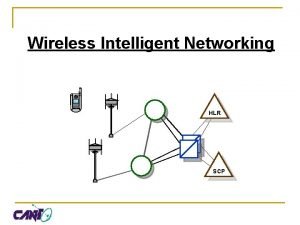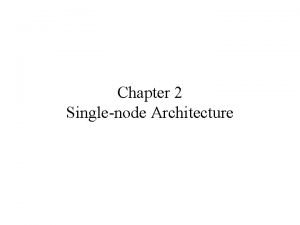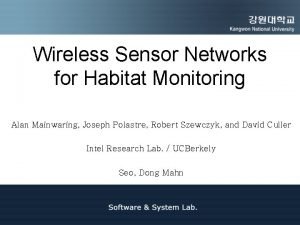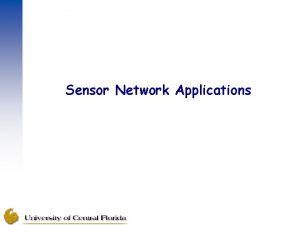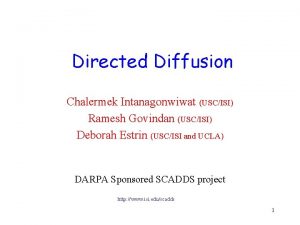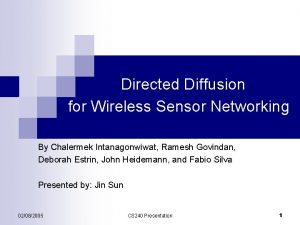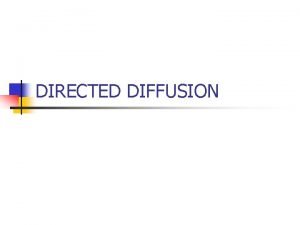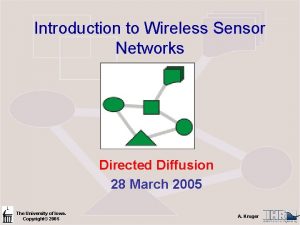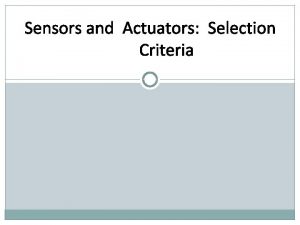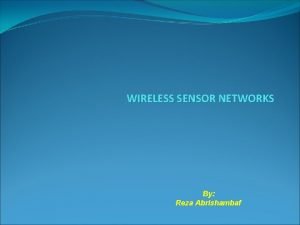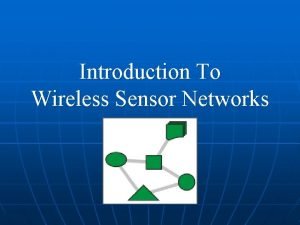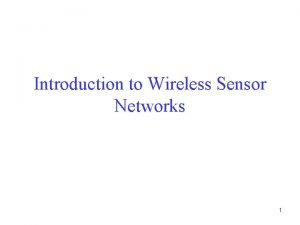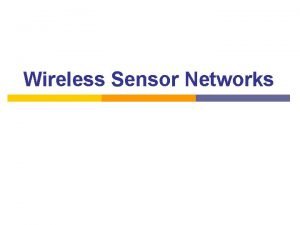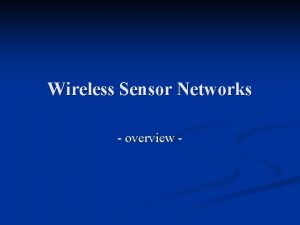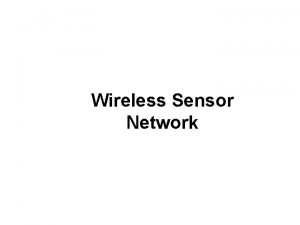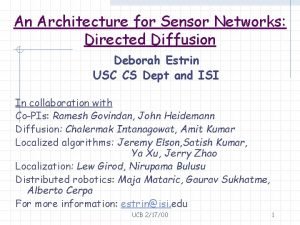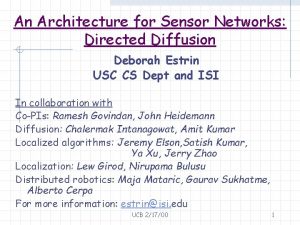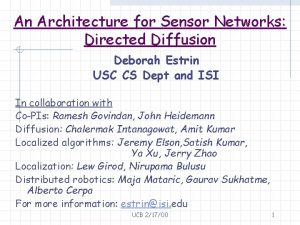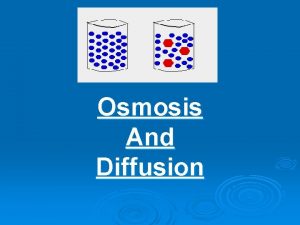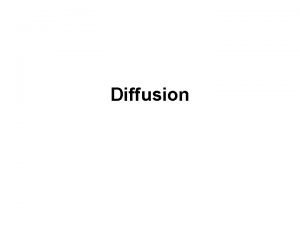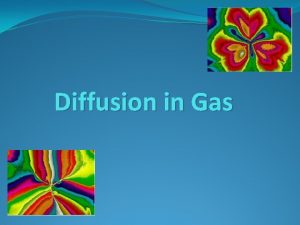Directed Diffusion for Wireless Sensor Networking C Intanagonwiwat





















- Slides: 21

Directed Diffusion for Wireless Sensor Networking C. Intanagonwiwat, R. Govindan, D. Estrin, John Heidemann, and Fabio Silva ACM/IEEE 2003 발표자 : 문동규


Contents w Introduction w Directed Diffusion n n n Simplified schematic for Directed Diffusion Data Naming Interest & Gradient Interest Propagation Data Propagation Reinforcement w Simulations w Conclusion

Introduction (1/2) w Wireless sensor networks n n Sensing devices with communication capability Event monitoring l Enemy detection, aircraft interiors, large industrial plants A sensor field Sources Even t w Data-centric communication n n Data is named by attribute-value Different form IP-style communication l End-to-end delivery service Directed Diffusion Sink Node

Introduction (2/2) w Data-centric communication (cont. ) n n Human operator’s query (task) is diffused Sensors begin collecting information about query Information returns along the reverse path Intermediate nodes aggregate the data l Combing reports from sensors w Challenges n n Scalability Energy efficiency Robustness / Fault tolerance in outdoor areas Efficient routing


Data Naming w Content based naming n n n Task are named: Attribute – value pair Selecting naming scheme important No globally unique ID for nodes: only locally unique Request: Interest Reply: Data type = four-legged animal interval = 20 ms interval = 1 s duration = 10 seconds rect = [-100, 200, 200] timestamp = 01: 20: 40 expires. At = 01: 30: 40

Interest & Gradient w Interest describes a task needed to be done by the sensor network n n n Interests are injected into the network at sink. Sink broadcasts the interest. Interval specifies an event data rate. Initially, requested interval much larger than needed. Node maintains an interest cache. w Interest entry also maintains gradients. n n Specifies a data rate and a direction (neighbor) Data flows from the source to the sink along the gradient

Interest Propagation w Flooding w Constrained or Directional flooding based on location. w Directional Propagation based on previously cached data. Gradient Source Interest Sink

Data Propagation w Reinforcement to single path delivery. w Multipath delivery with probabilistic forwarding. w Multipath delivery with selective quality along different paths. Gradient Source Data Sink

Reinforcement w Reinforce one of the neighbor after receiving initial data. n n n Neighbor(s) from whom new events received. Neighbor who’s consistently performing better than others. Neighbor from whom most events received. Gradient Source Data Reinforcement Sink

Negative Reinforcement(1/2) w Explicitly degrade the path by re-sending interest with lower data rate. w Time out Gradient Source Data Reinforcement Sink

Negative Reinforcement(2/2) w Using negative reinforcement n n Path Truncation Loop removal l l For resource saving B negative reinforces D, D negative reinforces E, …

Performance Evaluation (1/7) w w w Simulator: ns-2 Network Size: 50 -250 Nodes Transmission Range: 40 m Constant Density: 1. 95 x 10 -3 nodes/m 2 (9. 8 nodes in radius( MAC: Modified Contention-based MAC Transceiver Energy Model: mimics a “sensor radio” n 660 m. W in transmission, 395 m. W in reception, and 35 m. W in idle w Comparison with n n Flooding Omniscient multicast

Performance Evaluation (2/7) w Average dissipated energy Average Dissipated Energy (Joules/Node/Received Event) 0. 018 0. 016 Flooding 0. 014 0. 012 0. 01 0. 008 Omniscient Multicast 0. 006 0. 004 Diffusion Due to the data-aggregation Nodes suppress duplicate location estimates 0. 002 0 0 50 100 150 200 Network Size 250 300

Performance Evaluation (3/7) w Average delay Average Delay (secs) 0. 35 0. 3 Flooding 0. 25 0. 2 0. 15 0. 1 0 Omniscient Multicast Diffusion 0. 05 0 50 100 150 200 250 Uncongested sensor 300 network Reinforcement rules find the low delay path Network Size

Performance Evaluation (4/7) w Impact of dynamics (Distinct event delivery ratio)

Performance Evaluation (5/7) w Impact of negative reinforcement Diffusion Without Negative Reinforcement Diffusion With Negative Reinforcement Prune off higher latency path

Performance Evaluation (6/7) w Impact of duplicate suppression Diffusion Without Suppression Diffusion With Suppression Negative reinforcement Suppress identical data sent

Performance Evaluation (7/7) • High idle radio power

Conclusion w Application-level data dissemination has the potential to improve energy efficiency significantly n n n Data-centric dissemination Reinforcement based adaptation of paths Duplicate suppression and aggregation w MAC for sensor networks needs to be designed carefully.
 Syntax directed translation example
Syntax directed translation example Sdn and traditional networking
Sdn and traditional networking Any time interrogation call flow
Any time interrogation call flow Wireless networking meaning
Wireless networking meaning Swabt
Swabt Relocation diffusion vs expansion diffusion
Relocation diffusion vs expansion diffusion Wireless sensor network ppt
Wireless sensor network ppt Wireless sensor network protocols
Wireless sensor network protocols Geoves butterfly wireless multi sensor
Geoves butterfly wireless multi sensor Single node architecture in wireless sensor networks
Single node architecture in wireless sensor networks Sst wireless
Sst wireless Wireless sensor networks for habitat monitoring
Wireless sensor networks for habitat monitoring Wireless sensor networks for habitat monitoring
Wireless sensor networks for habitat monitoring Telecommunications the internet and wireless technology
Telecommunications the internet and wireless technology Fredsgudinna pax
Fredsgudinna pax Ekologiskt fotavtryck
Ekologiskt fotavtryck Datumr
Datumr Vilken grundregel finns det för tronföljden i sverige?
Vilken grundregel finns det för tronföljden i sverige? Bamse för de yngsta
Bamse för de yngsta Bästa kameran för astrofoto
Bästa kameran för astrofoto Ministerstyre för och nackdelar
Ministerstyre för och nackdelar Tillitsbaserad ledning
Tillitsbaserad ledning


